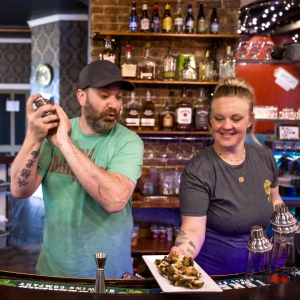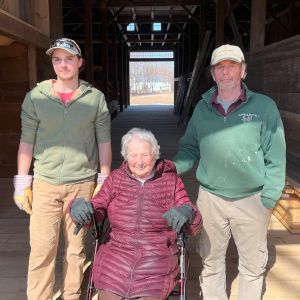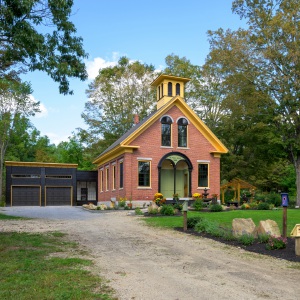Rindge farm supplies the nation with rare dahlias
| Published: 05-17-2020 11:00 AM |
Rindge farmers Craig and Megan Jensen scrambled to adapt to pandemic conditions at Sun Moon Farm this spring while interest and sales exploded. As they readied vegetable seedlings in greenhouses and finalized CSA subscriber lists throughout April, a wrenching decision weighed on them: Should they plant dahlias?
Sun Moon Farm grows commercially extinct varieties for the niche mail-order company Old House Gardens out of Ann Arbor, Michigan. It’s an heirloom bulb company that supplies avid home gardeners with delicate flower rarities. Trouble began when the company closed for two weeks in response to stay-at-home orders, right after they’d received the farm’s 2019 tubers, but before spring orders shipped out to customers.
It was enough to make the Jensens pause before they spent a week planting the finicky bulbs. For a while, Craig Jensen said he wasn’t sure whether he’d get paid for last year’s bulbs, or whether the distributor would still be in business by harvest time this fall.
Biology compounded the dilemma. Much like an apple tree, if you were to plant a dahlia seed, it wouldn’t grow the same variety as its parent plant. Instead, gardeners plant dahlia tubers of known varieties in the spring, which flower throughout the summer. If the Jensens chose to sit this season out, the tubers packed in sawdust in their cellar would be unviable by next year.
This wouldn’t just be a loss to the Jensens, though. For some of the dahlia varieties they grow, the Jensens keep the majority of the nation’s supply – a local version of the Svalbard Global Seed Vault. What’s a grower of heirloom flowers to do?
Their supplier put them at ease soon enough. Spring sales were especially high this year, Old House Gardens owner Vanessa Elms said, and the company reached out to assure the Jensens of their commitment to the future. They even offered a down payment on 2021 sales, Jensen said. So, the 3,000 precious bulbs came out of the basement to stage in the farm’s propagation greenhouse, awaiting dry conditions for planting.
The Jensens’ involvement in the world of heritage dahlia propagation started at their wedding on the farm in 2011. “We grew a reckless amount of flowers,” Craig said. They continued to maintain the beautiful and rare varieties for their own enjoyment, as well as for their customers, who periodically receive bouquets in their CSAs, or order them for their own weddings. Megan’s mother used to work for Old House Gardens, and connected the farmers to the company, who had them grow one variety the first year, and then two the next year. Today the farm is at saturation, Jensen said, with neither the time nor space to take on any more work for the company. They are one of the company’s two American dahlia suppliers, with a third supplier in the Netherlands.
What makes these rare dahlia varieties so special? Flowers were more culturally important in years past, Jensen said, and many of the varieties grown on the farm were wildly popular 50 or more years ago. White Aster, for example, is the oldest continuously grown dahlia variety and gained widespread popularity in the 1880s.
Article continues after...
Yesterday's Most Read Articles
 ‘Deep flavor’ – New restaurant in downtown Concord offers creative spin on comfort food and cocktails
‘Deep flavor’ – New restaurant in downtown Concord offers creative spin on comfort food and cocktails
 ‘Over-regulation is going to create sneakier kids’: Concord High students react to impending bell-to-bell phone ban
‘Over-regulation is going to create sneakier kids’: Concord High students react to impending bell-to-bell phone ban
 Photos: A Downtown ‘I Do’ at Market Days in Concord
Photos: A Downtown ‘I Do’ at Market Days in Concord
 Kenney family of Boscawen earns state preservation award for restoration of 19th-century barn
Kenney family of Boscawen earns state preservation award for restoration of 19th-century barn
 Concord receives federal funding to clean old stables, paving way for stagecoach museum
Concord receives federal funding to clean old stables, paving way for stagecoach museum
 Concord-area runners tackle Mt. Washington Road Race
Concord-area runners tackle Mt. Washington Road Race
The advent of mechanized farming favored dahlia varieties that could stand up to mechanical planting and harvesting, Jensen said. The types he grows are just as beautiful as they were in their heyday, but are fragile enough that they must be harvested by hand. A less discriminating gardener can buy three of a sturdier, tractor-friendly variety at Home Depot for $6, whereas the labor-intensive tubers Jensen grows go for up to $18.50 apiece. “I can’t sell them”, he said, without being plugged into Old Home Gardens’ national network of “fanatical” home gardeners.
Every step of the propagation process is difficult with heirloom varieties. “It’s all awful,” Jensen said. Unlike seed potatoes, which can sprout from multiple spots, heirloom dahlias only sprout from the end of a long, delicate neck. Any damage to the neck, and the tuber won’t sprout. Even dangling a dahlia bulb from a pitchfork puts too much strain on it, Jensen said. Furthermore, the tubers must be harvested in the narrow window in the fall after the plant is killed by frost, but before the soil around the tubers freezes, just six to eight inches below – and at a time of the year after all the seasonal help is gone. The check they receive from their bulb sales, although important for business, just doesn’t cover the work and worry that goes into the process, Jensen said.
Growing dahlia tubers might not make much sense from a business perspective, Jensen said, but he feels a certain cultural obligation to keep the dahlia strains from going extinct – although there are close calls. One winter, their two crates containing 50 Arab Queen tubers were set too close to the cold cellar wall and only seven survived, he said. Old House Gardens’ website has a page devoted to varieties that may be lost forever or are too few to sell due to severe weather conditions, or a sole grower’s health or financial problems.
“I definitely lose varieties every season,” Elms said, probably about three a year across the catalog, which includes daffodils, tulips, and other bulb flowers. “Sometimes I get a heads up, sometimes I don’t. If it’s a variety of tulip growing in Holland, maybe we can buy the last thousand bulbs and get them to a grower,” for propagation, she said. One of the perks of noting the lost and discontinued varieties is that sometimes, a customer or enthusiast will offer to distribute some of their personal stock. Other commercial suppliers of dahlias are very small scale, Elms said, and might offer 15 total bulbs of rare varieties at a time.
Shipping a live product is always hard in spring, Elms said, because you have to wait until there’s low risk of a bulb freezing in transit. This year, some orders took two or three times longer than usual to deliver, heightening the risk that bulbs would be damaged.
On Wednesday, Elms predicted the company’s dahlias would sell out in the next day or so. “People seem very excited to be at home and gardening based on the numbers I see,” she said, and is not too worried about fall season sales. Next, she’ll come up with what to offer customers in the fall, she said, hopefully including some new – old peony and daffodil varieties.
There are some excellent resources out there for identifying old and rare varieties of flowers, Elms said. For daffodils, there’s daffseek.org, where visitors can plug in characteristics of their variety and browse photo archives. The Historic Iris Preservation Society maintains a photo archive of irises. A detailed list of dahlia growers are listed on the Colorado Dahlia Society website.
]]>







 Around Concord: Living in an 1856 schoolhouse is (mostly) delightful
Around Concord: Living in an 1856 schoolhouse is (mostly) delightful Granite Geek: The circle of life is painful when watching the species-gets-killed part
Granite Geek: The circle of life is painful when watching the species-gets-killed part Concord’s two Rite Aid stores shutting soon
Concord’s two Rite Aid stores shutting soon
